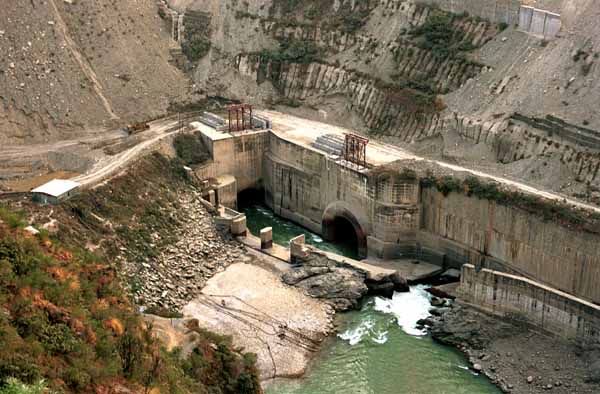| Section 2: Dams on the
Ganga
|
||
| SECTION 1
SECTION 2 SECTION 3 SECTION 4 SECTION 5 SECTION 6 SECTION 7 SECTION 8 SECTION 9 SECTION 10 SECTION 11
|
  
Dams on the Ganga
There are two major dams on the Ganga. One at Haridwar diverts much of the Himalayan snowmelt into the Upper Ganges Canal, built by the British in 1854 to irrigate the surrounding land. This caused severe deterioration to the wateflow in the Ganga, and is a major cause for the decay of Ganga as an inland waterway. The other dam is a serious hydroelectric affair at Farakka, close to the point where the main flow of the river enters Bangladesh, and the tributary Hooghly (also known as Bhagirathi) continues in West Bengal past Calcutta. This barrage, which feeds the Hooghly branch of the river by a 26 mile long feeder canal, and its water flow management has been a long-lingering source of dispute with Bangladesh, which fortunately is likely to be resolved based on discussions held with the new Hasina government in Bangladesh in 1996 when I.K. Gujral was the Foreign Minister in India, Failure to resolve this has caused harm to both sides of the border for nearly two decades now. Bangladesh feels that the lack of flow in the summer months causes sedimentation and makes Bangladesh more prone to flood damages. At the same time, proposals for linking the Brahmaputra to the Ganges to improve the water flow in the Ganges is hanging fire. Also, the water management problem may actually involve a number of other riparian countries such as Nepal (where there has been tremendous deforestation, leading to greater silt content). (Click here to read about causes of floods in Bangladesh [long].) It is likely that Ganga carried more water around the time of the Roman Empire, when Patna was the major port city of Pataliputra. Even in the eighteenth century the ships of the East India Company would come to call at the port city of Tehri, on the Bhagirathi, one of the main source river of Ganga. Another dam is proposed to be built on the upper reaches of a tributary of the Ganga, Mahakali, This Indo-Nepal project, the Pancheswar dam, proposes to be the highest dam in the world and will be built with US collaboration. The upper and lower Ganga canal, which is actually the backbone of a network of canals, runs from Haridwar to Allahabad, but maintenance has not been very good and my personal experience is that it probably trickles out into a small river a little beyond Kanpur.
|

